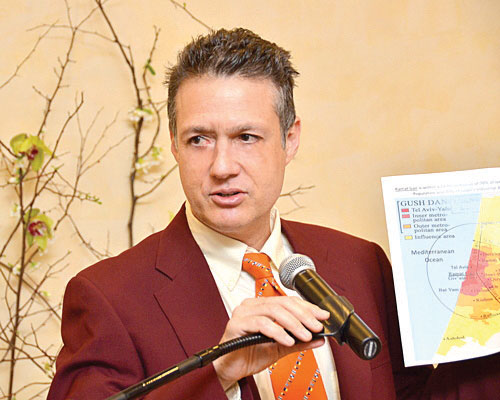.jpg)
Israeli Minister of Tourism Uzi Landau caused a media stir last month when, at a cabinet meeting, he quoted from former Israeli foreign minister Abba Eban’s statement that Israel’s 1967 borders are reminiscent of “Auschwitz” because of their indefensibility. But New York attorney Mark Langfan has been saying—rather, portraying—that same point for years.
Langfan for more than two decades has been designing his own Middle East maps—which depict what he calls “actual conditions” in the region, including topography, natural resources, geopolitics, and trade and transportation routes—and schlepping (as he puts it) them to Capitol Hill, where members of Congress from day one told him their constituents believe Israel is an apartheid state.
“The maps provided a tool to enable [legislators] to say to these people, basically, Israel should exist,” Langfan says in an interview with JNS.org.
Langfan says his maps work off the assumption that the 1967 “Auschwitz borders” mentioned by Landau “are indefensible and will cause another Holocaust.” Furthermore, the maps seek to counter the assumption of Israel’s enemies that all of the problems in the Middle East “are because of the Jews.”
“According to that theory, if Israel is gone, all the regional problems are solved,” Langfan says. “Well, that’s not exactly what would be likely to happen.”
The motivation behind Langfan’s self-funded maps project, he says, is “trying to leverage the maps as a valuable tool to help Israel.”
“The issues of the Middle East are complex and multifaceted,” Langfan says. “The maps serve as a tool to help explain the realities and put them into perspective—an important means of presenting issues to Congress and American and Israeli Jews.”
Langfan presents his maps in 8-10 minute explanatory talks during which the understanding of topography “becomes an important, simple base for additional information,” he says.
“These are not interpretive renditions of reality,” he says. “These maps show the actual conditions on the ground, presented for the sake of understanding. The intent is to be able to lecture to informed, varied audiences, from high school kids to generals and everyone in between.”
One of Langfan’s maps details major Palestinian rocket-launching sites, showing the close proximity of those battlements to Israeli population centers.
“When you realize that both Hezbollah and Hamas can fire rockets—like firing from Brooklyn to Manhattan—it really brings home the reality of the distance, really, the lack of distance [between rocket-launching sites and Israel],” Langfan says.
Another Langfan map, designed around the issue of energy control, “simplifies understanding of the politics of energy,” he says.
“The [Middle East] has 370 million Muslims and 11 million Christians in Greece,” Langfan explains. “The only barrier between them is Israel. Without Israel, the Muslims will seek to conquer Greece and Cyprus. If Israel were not there, would oil and gas revenues be shared with the Christians of Cyprus? The discovery of natural gas and oil reserves makes the existence of a strong Israel all the more important.”
Gaining control over what Langfan calls the “Black GoldTriangle—the oil-rich strip along the east and west coasts of the Persian Gulf—is what Langfan says the “world chess game is all about.”
“Each component is a piece of puzzle,” he says. “Oil is key. OPEC represents 78 percent of the world’s oil—this area has 56 percent of that supply.”
Langfan points out that Shi’ite Muslims hold virtually all of the Middle East oil reserves, even in Sunni-governed Saudi Arabia. He believes that Iran’s encouragement of the continuation of turmoil in Syria “is not over Syria,” but rather over the oil triangle.
“For Iran, it’s a question of controlling territory—a smothering campaign,” Langfan says. “Amman (the capital of Jordan) and Jerusalem are hardly involved.”
In almost any conversation about the Middle East, the question of Iran’s attempt to develop nuclear weapons capacity arises. Langfan says the Iranians “are not fools” and “have placed their nuclear facilities in as protected a place as possible.” A strike on Iran’s nuclear facilities “means crossing 4,500 meter-high-mountains,” he says, explaining that attacking Iran is a tougher proposition than attacking Iraq, where all of the nuclear facilities are to the east of the mountains.
Regarding Israel, Langfan says, “The strategic value of that little piece of land is extraordinary.” He is opposed to a two-state solution to the Israeli-Palestinian conflict and says the American Israel Political Affairs Committee (AIPAC) “has a problem” on that issue.
“[AIPAC] has supported the two-state solution, but its position has morphed into one that recognizes Israel as a strategic asset of the United States,” Langfan says, calling that position a “contradiction” because the two stances are “mutually exclusive.”
“No matter what Israeli general or politician you speak to, they all say ‘We will take painful risks for the peace process,’” Langfan says. “They never mention Israel as a strategic asset. If you have a strategic asset, do you expose your strategic asset to pain and risks for peace?”
“Israel is not a dependent little entity that needs to beg for its existence,” he adds. “Rather, the Jewish state is a vital component in maintaining the integrity of western civilization.”
Ultimately, Langfan dismisses the approach of those who believe “we have to beg for Israel and beg the politicians” to support of the Jewish state.
“My approach is radically different,” he says. “If you think there are problems in the Middle East now, think what would happen if there were no Israel.”
By Maxine Dovere/JNS.org








